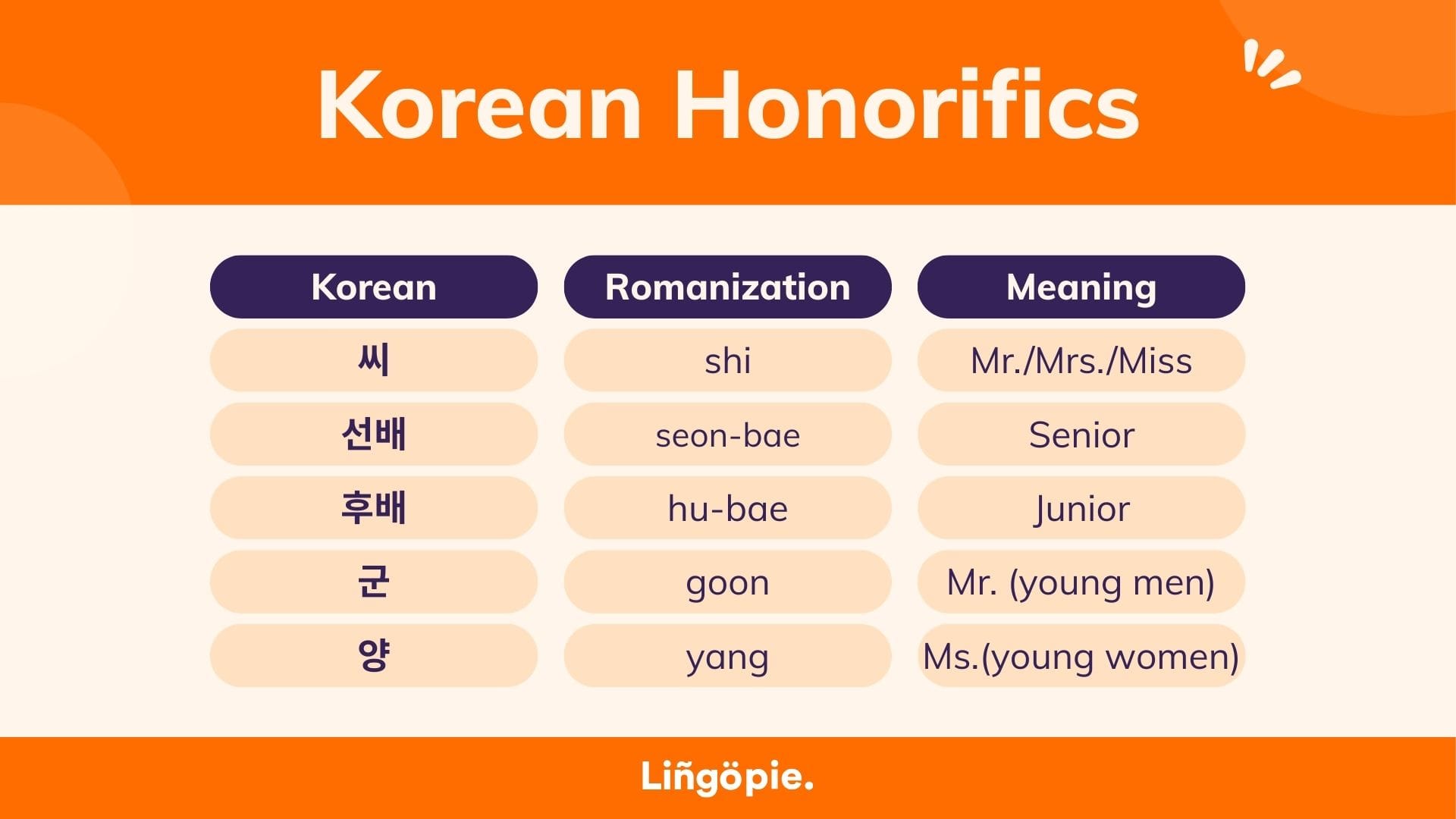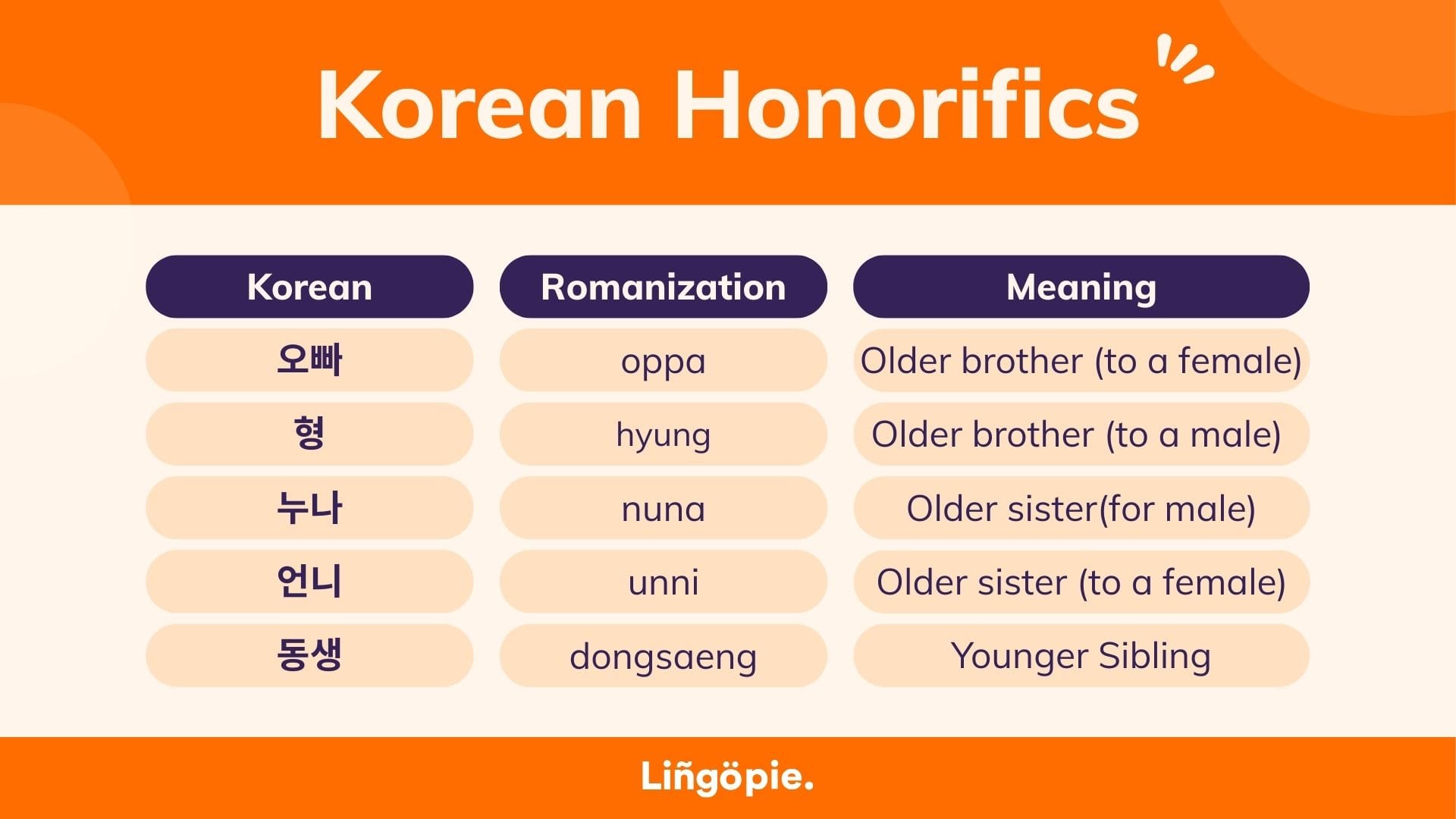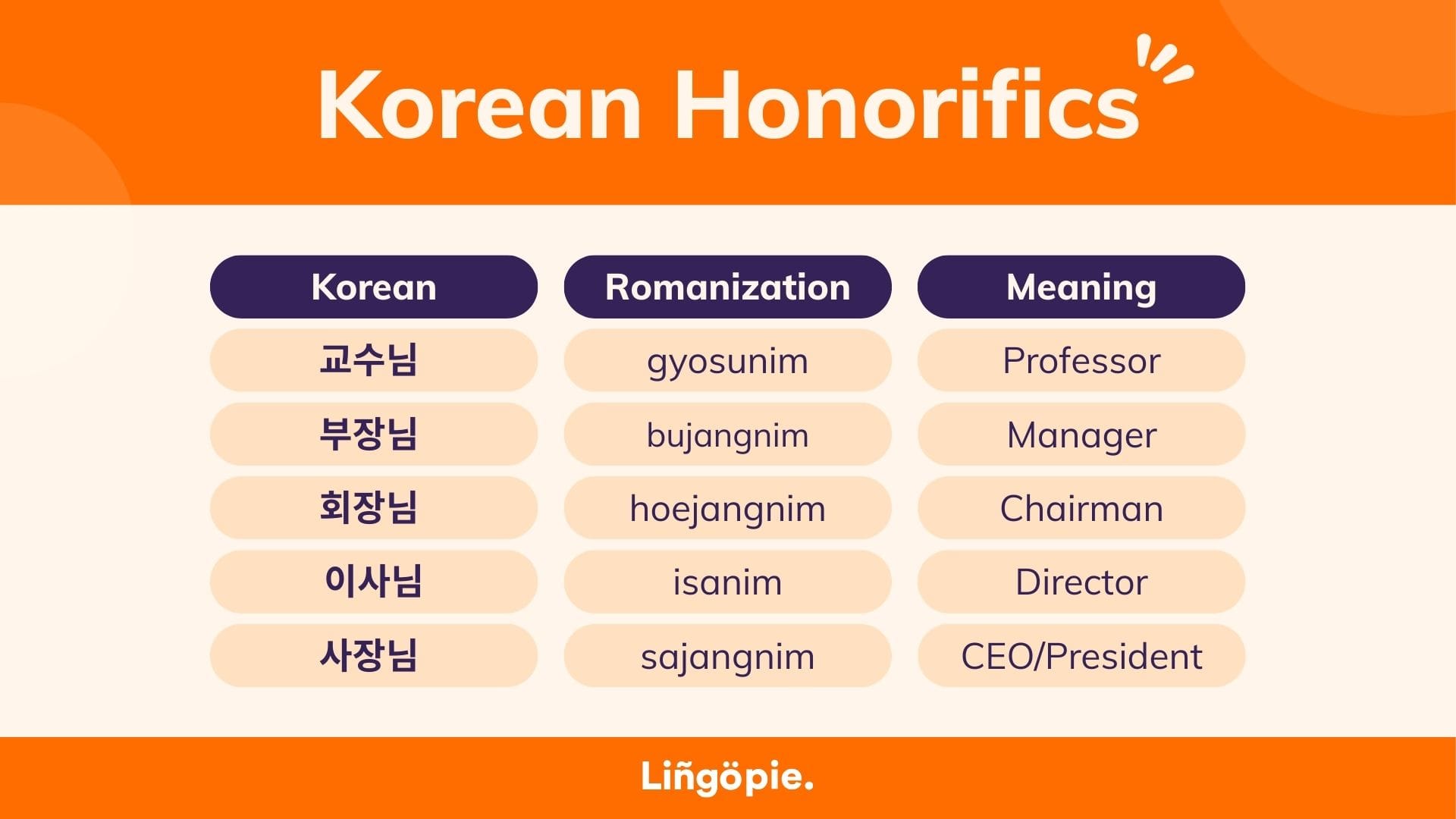Understanding Korean Honorifics is crucial for anyone who wants to learn how to read or write in Korean. This guide delves into the intricacies of the Korean language, providing practical insights for learners navigating the complexities of Korean honorifics.
Read on to discover practical insights and essential information that will enhance your communication in Korean and general cultural understanding. Let’s get into it.

Common Korean Honorifics and Honorific Form
Korean honorifics serve as a linguistic code, signaling respect in formal speech (and in everyday life), and are crucial the understanding of social hierarchies.
Forgetting to use Korean honorifics can be perceived as disrespectful, making it essential to navigate these linguistic nuances with finesse.
Understanding the most common Korean honorifics is the first step in your journey to learning to read and write in Korean. The key thing to remember is that the usage of Korean honorifics varies based on familiarity, social standing, and context.
Here's a brief overview of key honorifics:

1. 씨 (shi) - Mr./Mrs./Miss:
This is a versatile honorific suitable for individuals at a relatively equal social and conversational standing. It’s always attached after the first name, avoiding attachment to the last name to prevent rudeness.
Example sentences:
- 김영철 씨, 무슨 음식을 좋아하세요? (Mr. Kim Young-chul, what food do you like?)
- 지안 씨, 나이가 어떻게 되세요? (Mrs. Ji-an, how old are you?)
2. 님 (nim) - Mr./Mrs./Miss
This is a step above 씨, used for individuals with notable skills or professional status. It can be added after a full name or just the first name.
Example sentences:
- 선생님, 저는 질문 있어요 (Teacher, I have a question.)
- 사장님, 회의가 언제예요? (Boss, when is the meeting?)
3. 선배 (sun-bae) - Senior
Senior: This is reserved for those senior in age or experience, commonly used in workplaces or schools. It can stand alone without attaching a name.
Example sentences:
- 선배님, 조언 좀 해주세요 (Senior, please give me some advice)
- 선배님, 함께 일하면서 많이 배우고 있어요 (Senior, I am learning a lot from working together)
4. 후배 (hu-bae) - Junior
This is used for individuals who are junior in standing and a younger sibling. Like 선배, it can stand alone without attaching a name.
Example sentences:
- 후배들, 오늘은 고생 많았어요 (Juniors, you worked hard today)
- 후배들, 항상 최선을 다해요 (Juniors, always do your best)
5. 군 (goon) - Mr. (young men)
This is reserved for young, unmarried males on formal occasions. It is not as common in everyday conversation to avoid condescension.
Example sentences:
- 하준 군, 오늘 식사 어때요? (Ha-joon, shall we have a meal together today)
- 지호 군, 오늘 수고 많았어 (Ji-ho, you worked hard today)
6. 양 (yang) - Miss (young women)
This is similar to 군 but for young, unmarried females.
Example sentences:
- 하린 양, 너의 도움이 필요해 (Ha-rin, I need your help)
- 수아 양, 너의 의견에 동의해요 (Su-ah, I agree with your opinion.)
7. 귀하 (gwi-ha)
Dear/Formal pronoun: This is a formal honorific often seen in writing, translating to "dear." It is used in formal letters or addressing esteemed clients.
Example sentences:
- 귀하의 의견을 소중히 생각하고 있습니다 (We value your opinion highly)
- 귀하의 지원에 감사드립니다 (We appreciate your support)

Common Korean Titles for Family
Family dynamics in Korean culture introduce specific honorific titles for siblings, reinforcing the importance of respecting elders. Through Korean TV shows, movies, and even Korean websites, you’ll quickly notice that titles and hierarchy are a key part of Korean societal structure.
These titles extend beyond biological relationships, emphasizing broader cultural values.
8. 오빠 (op-pa) - Older brother (to a female)
This is used when a female refers to her older brother or an older brother-like figure.
Example sentences:
- 오빠, 피곤해요? (Are you tired?)
- 같이 가요, 오빠 (Let’s go together)
9. 형 (hyung) - Older brother (to a male)
This is employed by males when referring to an older brother or an older brother-like figure.
Example sentences:
- 형, 오랜만이에요! (It’s been a while!)
- 지금 바빠요, 형? (Are you busy right now?)
10. 누나 (nu-na)
Older sister (to a male): This is used by males when referring to an older sister or an older sister-like figure.
Example sentences:
- 누나, 어디 가요? (Where are you going?)
- 누나, 잘 지냈어요? (How have you been?)
11. 언니 (un-ni) - Older sister (to a female)
This is employed by females when referring to their older sister or an older sister-like figure.
Example sentences:
- 언니, 제일 좋아하는 색깔이 뭐예요? (What’s your favorite color?)
- 언니, 지금 뭐 하세요? (What are you doing right now?)
Related:



3. How to Use Honorifics in Korean
As established, understanding when and how to use specific Korean honorifics and honorific forms is crucial for fluent speakers in Korean.
This section provides insights into the contextual application of honorifics, ensuring language learners navigate the complexities with ease.
Honorific Verbs
Korean boasts a set of honorific verbs, offering a more polite version of standard verbs.
These verbs demonstrate respect towards older individuals or those in higher positions. It's imperative to incorporate these Korean honorific verbs seamlessly into conversations.
Example honorific verbs:
- 말하다 (to speak) → 말씀하시다 (an honorific form of “to speak”): Employed to show respect when referring to speaking.
- 먹다 (to eat) → 드시다 (an honorific form of “to eat”): Used to convey respect when discussing eating habits.
- 주다 (to give) → 드리다 (an honorific form of “to give”): Employed to express politeness when discussing giving.
- 있다 (to be/to exist) → 계시다 (an honorific form of “to be/exist”): Demonstrates respect when discussing existence.
Additionally, the Korean honorific particle -시 or -으시 can enhance standard verbs' politeness.
However, it's crucial to adapt the writing and pronunciation based on the chosen speech politeness level.
Example sentences with honorific verbs:
- 말씀하시다 (Please speak.)
- 드시다 (Please eat.)
- 드리다 (Please give.)
- 계시다 (You are.)
Honorific Pronouns
Pronouns are a crucial element of language, and in Korean, the choice of pronouns reflects the level of politeness and formality. While various pronouns exist, not all are suitable for polite or formal situations.
Example honorific pronouns:
- 나 (casual “I”) → 저 (formal “I”): Transition from a casual to a formal "I" for increased politeness.
- 우리 (casual “our”) → 저희 (formal “our”): Elevate the formality when referring to the collective "our."
In polite and formal settings, addressing individuals by their names with appropriate suffixes or titles often replaces the casual term for "you" (너).
Honorific Nouns
There are Korean honorific nouns for objects, emphasizing the importance of demonstrating respect even in discussions about inanimate things concerning someone in a higher position.
Example honorific nouns:
- 집 (house) → 댁 (honorific for “house”): Polite term for discussing someone's house.
- 사람 (person) → 분 (honorific for “person”): Respectful way to refer to a person in relation to someone in a higher position.
- 나이 (age) → 연세 (honorific for “age”): Polite term for discussing age in a respectful manner.
- 이름 (name) → 성함 (honorific for “name”): Demonstrates respect when referring to someone's name.
4. More Honorific Titles in Korean
Korean society incorporates a range of honorific titles for various professions and positions, each reflecting the cultural emphasis on respect and hierarchy.
Understanding these titles is crucial for effective communication in professional and social settings.

Example honorific titles:
- 교수님 (Professor): Used to address professors in academic settings.
- 부장님 (Manager): A respectful title for addressing managers in the workplace.
- 회장님 (Chairman): Employed in formal situations when addressing chairpersons.
- 이사님 (Director): Used to address directors in various contexts.
- 사장님 (CEO/President): A formal title for addressing the chief executive officer or president.
- 사모님 (Mrs./Madam): A polite way to address married women.
- 부모님 (Parents): A respectful term for referring to one's parents.
- 회원님 (Member): Used in various organizational settings to address members.
- 고객님 (Customer): Employed in business contexts to address customers.
- 여사님 (Madam/Wife): A polite way to address married women.
- 신부님 (Priest): Used to address priests in religious contexts.
- 목사님 (Pastor): A respectful title for addressing pastors.
- 감독님 (Director/Supervisor): Used in professional settings to address directors or supervisors.
- 대표님 (Representative): A formal title for addressing company representatives.
- 소장님 (Chief/Curator): Used in cultural institutions to address chiefs or curators.
- 손님 (Guest): A term used to address guests with respect.
Fun fact: "Korean age," rooted in the lunar calendar, adds cultural nuance to age calculation.
With everyone gaining a year on the lunar new year, regardless of birthdate, individuals born in the same year may have different Korean ages.
This unique system reflects Korea's deep connection to its lunar calendar traditions.
FAQs
This section provides answers to common questions relating to Korean honorifics, as well as formalities, levels of importance, and the dynamics of addressing friends in the Korean language.
What is the formal honorific in Korean?
In Korean, the formal honorific is often expressed through the use of "요" (yo) or "입니다" (imnida) to convey politeness and respect, especially in professional and formal settings.
How many levels of Korean are there?
Korean features several speech levels, including formal, informal, and polite forms. The number of levels can vary, but understanding and navigating these levels is crucial for effective communication in diverse social contexts.
Why are Korean honorifics important?
Korean honorifics are vital as they reflect cultural values, emphasizing respect and maintaining social harmony. Proper use of Korean honorifics showcases politeness, acknowledges social hierarchies, and fosters positive communication in various settings.
What are honorifics for friends in Korean?
Addressing friends in Korean involves informal language. While Korean honorifics may be less prominent among peers, a level of politeness is maintained. Slightly more casual language, minus formalities, is typically used to convey a sense of familiarity and friendship.
Summing up: Korean Honorifics
Mastering Korean honorifics is not an instant achievement but a gradual process. With diligent practice and exposure to real-life conversations, language learners can confidently navigate the intricacies of honorific usage.
Understanding Korean honorifics opens doors to meaningful interactions in Korean, and enables you to connect with Korean society.
If you wish to find a place where you can hear all these Korean honorifics and learn more about Korean culture, then check out Lingopie.
On the Lingopie platform, you have access to a vast catalog of Korean TV shows and movies, alongside language learning tools.
Sign up for seven days of access today, completely free of charge.


![Complete Korean Honorifics Guide For Beginners [2026]](/blog/content/images/size/w1200/2024/08/Lingopie-1.png)







